
| ||||
|---|---|---|---|---|
 |
 |
 |
 |
 |



























| ||||
|---|---|---|---|---|
 |
 |
 |
 |
 |


























Mikoyan-Gurevich UTI MiG-15 Midget
Soviet single-engine two-seat swept-wing jet trainer.
.jpg)
Archive Photos 1
1954 Mikoyan-Gurevich MiG-15UTI Midget (N41125/01, c/n 242266) on display at the Mojave Airport, Mojave, California (Photos by John Shupek)
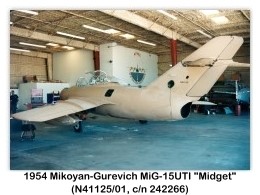
1954 Mikoyan-Gurevich MiG-15UTI Midget (N41125/01, c/n 242266) on display 4/1/2001 Pt. Mugu Airshow (Photos by John Shupek)

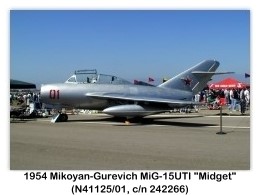
1953 Mikoyan-Gurevich MiG-15UTI Midget (NX687, s/n 1A02005, Red Bull) on display (8/19/2006) at the 2006 Camarillo Air Show, Camarillo, California (Photos by John Shupek)

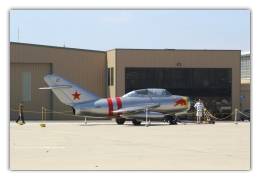
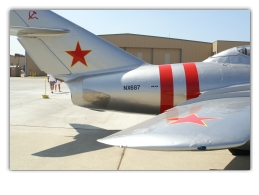
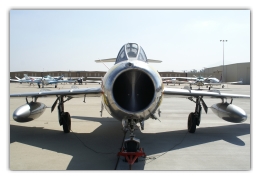

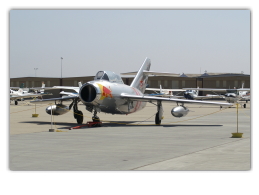

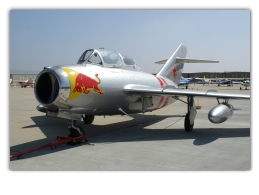

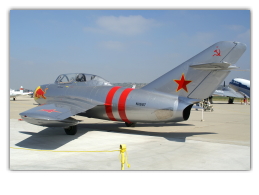

Mikoyan-Gurevich MiG-15UTI Midget (163) on display (8/21/2008) at the Förderverein des Luftwaffenmuseums der Bundeswehr e.V., Bundesgeschäftsstelle, Berlin, Germany (Photos by John Shupek)






Overview 2
The Mikoyan-Gurevich MiG-15 Fagot was a jet fighter developed for the USSR by Artem Mikoyan and Mikhail Gurevich. The Mikoyan-Gurevich MiG-15 Fagot was one of the first successful swept-wing jet fighters, and it achieved fame in the skies over Korea, where early in the war, it outclassed all straight-winged enemy fighters in most applications. The Mikoyan-Gurevich MiG-15 Fagot also served as the starting point for development of the more advanced Mikoyan-Gurevich MiG-17 Fresco jet fighters which was still an effective threat to American fighters during the Vietnam War. The Mikoyan-Gurevich MiG-15 Fagot is believed to have been the most widely produced jet aircraft ever made, with over 12,000 built. Licensed foreign production perhaps raised the total to over 18,000. The Mikoyan-Gurevich MiG-15 Fagot is often mentioned along with the North American F-86 Sabre in lists of the best fighter aircraft of the Korean War and in comparison with fighters of other eras.
Design and Development 2
The first Soviet turbojet fighter developed by Mikoyan-Gurevich was the Mikoyan-Gurevich MiG-9 Fargo which appeared in the years immediately after World War II. It used a pair reverse-engineered German BMW 003 engines, which had been experimentally used on the Messerschmitt Me.262A-1b test aircraft, only a few of which were ever built. The Mikoyan-Gurevich MiG-9 Fargo was a troublesome design which suffered from weak, unreliable engines and control problems. Categorized as a first generation jet fighter, it was designed with straight wings like previous piston-engine fighters which were encountering performance problems as their performance approached the speed of sound.
The Germans never developed good turbojets with thrust over 2,500 lb which limited the performance of Soviet jet designs. By 1946, Soviet designers were impressed by the Rolls-Royce Nene engine. Soviet aviation minister Mikhail Khrunichev and aircraft designer A. S. Yakovlev suggested to Premier Joseph Stalin the USSR buy advanced jet engines from the British. Stalin is said to have replied, What fool will sell us his secrets?
However, he gave his consent to the proposal and Mikoyan, engine designer Vladimir Klimov, and others traveled to the United Kingdom to request the engines. To Stalin’s amazement, the British Labor government and its pro-Soviet Minister of Trade, Sir Stafford Cripps, were perfectly willing to provide technical information and a license to manufacture the Rolls-Royce Nene. This engine was reverse-engineered and produced as the Klimov RD-45, subsequently incorporated into the Mikoyan-Gurevich MiG-15 Fagot. Rolls-Royce later attempted to claim £207 million in license fees, without success.
To take advantage of the new engine, the Council of Ministers ordered the Mikoyan OKB to build two prototypes for an advanced high-altitude day interceptor to defend against bombers. It was to have a top speed of 621 mph and a range of 745 miles.
Designers at MiG’s OKB-155 started with the earlier Mikoyan-Gurevich MiG-9 Fargo jet fighter. The new fighter used Klimov’s new British designed engines, and applied swept wings and a tailpipe which went all the way Back to a swept tail. Germany was the first nation to fit their Messerschmitt Me.262 with a 18.5° wing sweep, but it was introduced merely to adjust the center of gravity of heavy engines. Further experience and research during World War II later established that swept wings would give better performance at transonic speeds. At the end of World War II, the Soviets seized most of Germany’s aircraft industry. The MiG team studied many of these plans, prototypes and documents, particular swept-wing research and designs. The swept wing later provided a decisive performance advantage over straight-winged jet fighters when it was introduced into combat over Korea
What emerged had a mid-mounted 35° swept wing with a slight downward anhedral and a tailplane mounted up on the swept tail. Western analysts noted that it strongly resembled Kurt Tank’s Focke-Wulf Ta.183, which was a never-flown swept-wing follow-on to the Messerschmitt Me.262 designed during World War II. The Mikoyan-Gurevich MiG-15 Fagot bore a much stronger likeness than the North American F-86 Sabre which also incorporated German research, though the new MiG retained the previous straight-winged Mikoyan-Gurevich MiG-9 Fargos wing and tailplane placement, and the North American F-86 Sabre inherited its low-wing from the North American FJ Fury. The two aircraft were otherwise similar enough in appearance to prompt US forces to paint their planes with bright stripes to distinguish them. The Soviets did capture the plans and prototypes for the Focke-Wulf Ta-183. The majority of Focke-Wulf engineers, in particular, Hans Multhopp, who led the Ta-183 development team, were captured by Western armies. It has been argued that The Mikoyan-Gurevich MiG-15 Fagot design team drew some limited inspiration from the Focke-Wulf Ta-183, but it is disputed that it was heavily influenced. One view is that The Mikoyan-Gurevich MiG-15 Fagot is an original design benefiting from German research, but conceived, designed, engineered, and produced by the Soviets. The unusual Mikoyan-Gurevich MiG-8 Utka experimental canard aircraft, built right at the conclusion of World War II by the MiG design bureau also lent experience in the use of swept wings on later Mikoyan designs.
The resulting prototypes were designated as Mikoyan-Gurevich I-310. The Mikoyan-Gurevich I-310 was a clean, swept-wing fighter with 35° sweep in wings and tail, and exceptional performance, with a top speed of over 1,040 km/h (650 mph). The design used a single engine fed by a split-forward air intake. A duct carried intake air around the cockpit area and Back together ahead of the engine. First fight was 30 December 1947. The similar North American F-86 Sabre had first flown only months earlier in October 1947.
Russia’s first swept-wing jet fighter was actually the underpowered Lavochkin La-160 which was otherwise more similar to the Mikoyan-Gurevich MiG-9 Fargo. The Lavochkin La-168 which reached production as the Lavochkin La-15 Fantail used the same engine as the MiG but with shoulder mounted wing and t-tail was the main competitive design. Eventually, the MiG design was favored for mass production. Designated MiG-15, the first production example flew on 31 December 1948. It entered Soviet Air Force service in 1949, and subsequently received the NATO reporting name "Fagot." Early production examples had a tendency to roll to the left or to the right due to manufacturing variances, so aerodynamic trimmers called "nozhi" (knives) were fitted to correct the problem, the knives being adjusted by ground crews until the aircraft flew correctly.
An improved variant, the Mikoyan-Gurevich MiG-15bis Fagot-B, entered service in early 1950 with a Klimov VK-1 engine, an improved version of the RD-45/Nene, plus minor improvements and upgrades. Visible differences were a headlight in the air intake separator and horizontal upper edge airbrakes. The 23 mm cannons were placed more closely together in their undercarriage. Some "bis" aircraft also adopted under-wing hardpoints for unguided rocket launchers or 50-250 kg (110-551 lb) bombs. Fighter-bomber modifications were dubbed "IB", "SD-21", and "SD-5". About 150 aircraft were upgraded to SD-21 specification during 1953-1954. An unknown number of aircraft were modified to "IB" specification in the late 1950’s.
The Mikoyan-Gurevich MiG-15 Fagot arguably had sufficient power to dive at supersonic speeds, but could not do so because it did not have an "all-flying" tail. As a result, the pilot’s ability to control the aircraft deteriorated significantly as it approached Mach 1. Later MiG’s incorporated all-flying tails.
The Mikoyan-Gurevich MiG-15 Fagot was originally intended to intercept American bombers like the Boeing B-29 Superfortress. It was even evaluated in mock air-to-air combat trials with a captured U.S. Boeing B-29 Superfortress, as well as the later Soviet B-29 copy, the Tupolev Tu-4 Bull. To ensure the destruction of such large bombers, The Mikoyan-Gurevich MiG-15 Fagot carried cannons: two 23 mm with 80 rpg and a single 37 mm with 40 rounds. These weapons provided tremendous punch in the interceptor role, but their limited rate of fire and relatively low velocity made it more difficult to score hits against small and maneuverable enemy jet fighters in air-to-air combat. The 23 mm and 37 mm also had radically different ballistics, and some United Nations pilots in Korea had the unnerving experience of 23 mm shells passing over them while the 37 mm shells flew under. The cannons were fitted into a neat pack that could be winched down out of the bottom of the nose for servicing and reloading, in principle allowing a pre-prepared pack to be switched for rapid turnaround.
A variety of Mikoyan-Gurevich MiG-15 Fagot variants were built, but the most common was the MiG-15UTI (NATO reporting name "Midget") two-seat trainer. Because Mikoyan-Gurevich never mass-produced the transition training versions of the later MiG-17 Fresco or MiG-19 Farmer, the MiG-15UTI Midget remained the sole Warsaw Pact advanced jet trainer well into the 1970’s, the primary training role being fulfilled exclusively by Czechoslovak Aero L-29 Delfin and the L-39 Albatros jet trainers. Poland, used their indigenous TS-11 Iskra jets in the training role. While China produced two-seat trainer versions of the later MiG-17 Fresco and MiG-19 Farmer, the Soviets felt that the MiG-15UTI Midget was sufficient for their needs and did not produce their own trainer versions of those aircraft.
Operational History 2
The Mikoyan-Gurevich MiG-15 Fagot was widely exported, with the People’s Republic of China receiving MiG-15bis models in 1950. Chinese MiG-15’s took part in the first jet-versus-jet dogfights during the Korean War. The swept-wing Mikoyan-Gurevich MiG-15 Fagot quickly proved superior to the first-generation, straight-wing jets of western air forces such as the Lockheed F-80 Shooting Star and British Gloster Meteor, as well as piston-engine North American P-51 Mustangs and Vought F4U Corsairs. The Mikoyan-Gurevich MiG-15 Fagot of First Lieutenant Semyon Fiodorovich Jominich scored the first jet-vs-jet victory in history when he bagged the Lockheed F-80C Shooting Star of Frank Van Sickle, who died in the encounter. The USAF credits the loss to the action of the North Korean flak). Only the North American F-86 Sabre, with its highly trained pilots, was a match for the MiG.
Its baptism of fire occurred during the last phases of the Chinese Civil War (1946-49). During the first months of 1950, the aviation of Nationalist China attacked from Taiwan the communist position in continental China, especially Shanghai. Mao Zedong requested the military assistance of the USSR, and the 50th IAD (Istrebitelnaya Aviadiviziya; Fighter Aviation Division) equipped with the Mikoyan-Gurevich MiG-15bis Fagot-B was deployed south of the People’s Republic of China. On 28 April 1950, Captain Kalinikov shot down a Lockheed P-38 Lightning of the Kuomintang, scoring the first aerial victory of the Mikoyan-Gurevich MiG-15 Fagot. Another followed on 11 May, when Captain Ilya Ivanovich Schinkarenko downed a Consolidated B-24 Liberator of Li Chao Hua, commander of the 8th Air Group of the Nationalist Air Force.
The Korean War (1950-1953)
When the ongoing Korean War escalated with the North Korean offensive of 25 June 1950, the Northern Air Force was equipped with World War II-vintage Soviet prop-driven fighters, including 93 Ilyushin Il-10’s and 79 Yakovlev Yak-9’s. The North Korean Air Force had roughly 93 Il-10’s, 79 Yak-9P’s, and 40-50 assorted transport/liaison/trainer aircraft". The vast numerical and technical superiority of the USAF, led by advanced jets such as Lockheed F-80 Shooting Star and Republic F-84 Thunderjet fighters, quickly brought air superiority, thus laying North Korea’s cities bare to the destructive power of USAF Boeing B-29 Superfortress bombers which, together with Navy and Marine aircraft, roamed the skies largely unopposed for a time.
The decision to introduce The Mikoyan-Gurevich MiG-15 Fagot not only closed the jet fighter gap, its performance leapfrogged all of the opposing straight-winged jets. The Mikoyan-Gurevich MiG-15 Fagot proved very effective in its designed role against formations of Boeing B-29 Superfortress heavy bombers, shooting down numerous bombers. In a match-up with the North American F-86 Sabre, the results were not as clear-cut though Americans claimed that the North American F-86 Sabre had the advantage in combat kills. The Soviet 64th IAK (Fighter Aviation Corps) claimed 1,106 UN aircraft destroyed in the Korean War, compared to Allied records that 142 Allied aircraft were downed by the Soviet Mikoyan-Gurevich MiG-15 Fagot pilots. Western experts do acknowledge many Soviet pilots earned bigger individual scores than their American counterparts due to a number of factors, though overall figures of NATO were probably overstated.
For many years, the participation of Soviet aircrews in the Korean War was widely suspected by the United Nations forces, but consistently denied by the Soviet Union. With the end of the Cold War, however, Soviet pilots who participated in the conflict have begun to reveal their role. Soviet aircraft were adorned with North Korean or Chinese markings and pilots wore either North Korean uniforms or civilian clothes to disguise their origins. For radio communication, they were given cards with common Korean words for various flying terms spelled out phonetically in Cyrillic characters. These subterfuges did not long survive the stresses of air-to-air combat, however, as pilots routinely communicated (cursed) in Russian. Soviet pilots were prevented from flying over areas in which they might be captured, which would indicate that the Soviet Union was officially a combatant in the war.
The USSR never acknowledged that its pilots ever flew over Korea during the Cold War. Americans who intercepted radio traffic during combat confirmed hearing Russian voices, but only the Communist Chinese and North Korean combatants took responsibility for the flying. Until the publishing of recent books by Chinese and Russian authors, such as Zhang Xiaoming, Leonid Krylov, Yuriy Tepsurkaev and Igor Seydov, little was known of the actual pilots. The Americans recognized the techniques of their opponents whom they called "honchos", and dubbed "MiG Alley" the site of numerous dogfights in the northwestern portion of North Korea where the Yalu River empties into the Yellow Sea.
The Soviets were training Chinese Mikoyan-Gurevich MiG-15 Fagot pilots when China entered the war in support of North Korea. By October, the Soviet Union had agreed to provide air regiments of state-of-the-art Soviet designed and built Mikoyan-Gurevich MiG-15 Fagot fighters, along with the trained crews to fly them. Simultaneously, the Kremlin agreed to supply the Chinese and North Koreans with their own Mikoyan-Gurevich MiG-15 Fagots, as well as train their pilots. On 1 November 1950, eight Mikoyan-Gurevich MiG-15 Fagots intercepted about 15 North American F-51D Mustangs of the United States Air Force (USAF) and First Lieutenant Fiodor V. Chizh shot down the North America F-51D Mustang of Aaron Abercombrie, killing the American pilot. Three Mikoyan-Gurevich MiG-15 Fagots of the same unit intercepted 10 Lockheed F-80 Shooting Stars, and First Lieutenant Semyon Fiodorovich Jominich scored the first jet-vs-jet victory in history when he downed the Lockheed F-80C Shooting Star of Frank Van Sickle, who would also perish. The USAF credits both losses to the action of the North Korean flak. However on 9 November, the Soviet Mikoyan-Gurevich MiG-15 Fagot pilots suffered their first loss when Lieutenant Commander William T. Amen off the aircraft carrier USS Philippine Sea shot down and killed Captain Mikhail F. Grachev while flying a Grumman F9F Panther.
The Soviet air units claimed to have shot down 29 American aircraft through the rest of the month: 11 Lockheed F-80 Shooting Stars, seven Boeing B-29 Superfortress bombers and nine Lockheed F-5 Lightnings. Twenty-three out of these 29 claims match acknowledged losses, but US sources assert that most of them were either operational or due to AAA, admitting only four Boeing B-29 Superfortress bombers (a downed B-29, plus two B-29’s and a RB-29 which crash-landed or were damaged beyond repair). US historians agree that The Mikoyan-Gurevich MiG-15 Fagot gained aerial superiority over northwestern Korea.
To counter this unexpected turn of events, three squadrons of the North American F-86 Sabre, America’s only operational jet with swept wings were quickly rushed to the Far East in December. On 17 December 1950, Lieutenant Colonel Bruce H. Hilton forced Major Yakov Nikanorovich Yefromeyenko to eject from his burning MiG. In the following days, both sides traded punches, with Captain Nikolay Yefremovich Vorovyov shooting down the North American F-86A Sabre of Captain Lawrence V. Bach in his Mikoyan-Gurevich MiG-15bis Fagot-B on 22 December 1950. Both sides exaggerated their claims of aerial victories that month. Sabre fliers claimed eight MiGs, and the Soviets twelve North American F-86 Sabres; the actual losses were three MiGs and at least four North American F-86 Sabres.
Those first encounters established the main features of the aerial battles of the next two and a half years. The Mikoyan-Gurevich MiG-15 Fagot and Mikoyan-Gurevich MiG-15bis Fagot-B had a higher ceiling than all versions of the North American F-86 Sabre, 15,500 m (50,900 ft) versus 14,936 m (49,003 ft) of the North American F-86F Sabre, and accelerated faster than North American F-86A/E/F Sabres due to their better thrust-to-weight ratio, 1,005 km/h (624 mph) versus 972 km/h (604 mph) of the North American F-86F Sabre. The Mikoyan-Gurevich MiG-15 Fagot’s 2,800 m (9,200 ft) per minute climbing rate was also greater than the 2,200 m (7,200 ft) per minute of the North American F-86A and F-86E Sabres. The North American F-86F Sabre matched the Mikoyan-Gurevich MiG-15 Fagot’s rate. A better turn radius above 10,000 m (33,000 ft) further distinguished the Mikoyan-Gurevich MiG-15 Fagot, as did more powerful weaponry - one 37 mm N-37 cannon and two 23 mm NR-23 cannons, versus the inferior hitting power of the six 12.7 mm (.50 in) machine guns of the North American F-86 Sabre. But the MiG was slower at low altitude - 935 km/h (581 mph) in the Mikoyan-Gurevich MiG-15bis Fagot-B configuration as opposed to the 1,107 km/h (688 mph) of the North American F-86F Sabre. The Soviet World War II-era ASP-1N gyroscopic gun sight was less sophisticated than the accurate A-1CM and A4 radar ranging sights of the North American F-86E and F-86E Sabres. All North American F-86 Sabres turned tighter below 8,000 m (26,000 ft).
Thus if The Mikoyan-Gurevich MiG-15 Fagot forced the North American F-86 Sabre to fight in the vertical plane, or in the horizontal one above 10,000 m (33,000 ft), it gained a significant advantage. Furthermore, a Mikoyan-Gurevich MiG-15 Fagot could easily escape from a North American F-86 Sabre by climbing to its ceiling, knowing that the North American F-86 Sabre could not follow him. Below 8,000 m (26,247 ft) however, the North American F-86 Sabre had a slight advantage over the MiG in most aspects excluding climb rate, especially if the Soviet pilot made the mistake of fighting in the horizontal plane.
The main mission of The Mikoyan-Gurevich MiG-15 Fagot was not to dogfight the North American F-86 Sabre, however, but to counter the USAF Boeing B-29 Superfortress bombers. This mission was assigned to the elite of the Soviet Air Force (VVS), in April 1951 to the 324th IAD of Colonel Ivan Kozhedub, the World War II Allied "Ace of Aces", and later to the 303rd IAD of General Georgiy A. Lobov, who arrived to Korea in June of that same year.
A total of 44 Mikoyan-Gurevich MiG-15 Fagots achieved victories in that mission on 12 April 1951 when they intercepted a large formation of 48 Boeing B-29 Superfortresses, 18 North American F-86 Sabres, 54 Republic F-84 Thunderjets and 24 Lockheed F-80 Shooting Stars heading towards the bridge linking North Korea and Red China over the Yalu river in Uiju. When the ensuing battle was finished, the experienced Soviet fliers had shot down or damaged beyond repair 10 Boeing B-29A Superfortress bombers, one North American F-86A Sabre and three Lockheed F-80C Shooting Stars for the loss of only one MiG.
U.S. strategic bombers returned the week of 22-27 October to neutralize the North Korean aerodromes of Namsi, Taechon and Saamchan, taking further losses to the Mikoyan-Gurevich MiG-15 Fagot. On 23 October 1951, 56 MiG-15bis Fagot-B fighters intercepted nine Boeing B-29 Superfortress bombers escorted by 34 North American F-86 Sabres and 55 Republic F-84E Thunderjets. In spite of their numerical inferiority, the Soviet airmen shot down or damaged beyond repair eight Boeing B-29A Superfortress bombers and two Republic F-84E Thunderjets, losing only one MiG in return and leading Americans to call that day "Black Tuesday". The most successful Soviet pilots that day were Lieutenant Colonel Aleksandr P. Smorchkov and 1st Lieutenant Dmitriy A. Samoylov. The former shot down a Boeing B-29 Superfortress on each of 22, 23 and 24 October. Samoylov added two North American F-86A Sabres to his tally on 24 October 1951, and on 27 October shot down two more aircraft: a Boeing B-29A Superfortress and an Republic F-84E Thunderjet. These losses among the heavy bombers forced the Far East Air Force’s High Command to cancel the precision daylight attacks of the Boeing B-29 Superfortress bombers, and only undertake radar-directed night raids.
During the period from November 1950 to January 1952, no less than 40 Soviet Mikoyan-Gurevich MiG-15 Fagot pilots were credited as aces, with five or more victories. Soviet combat records show that the first pilot to claim his fifth aerial victory was Captain Stepan Ivanovich Naumenko on 24 December 1950. The honor falls to Captain Sergei Kramarenko, when on 29 July 1951, he scored his actual fifth victory. Approximately 16 out of those 40 pilots actually became aces, the most successful being Major Nikolay Sutyagin, credited with 22 victories, 13 of which confirmed by the US; Colonel Yevgeny Pepelyaev with 19 claims, 15 confirmed victories; and Major Lev Shchukin - 17 credited, 11 verified.
At least two Soviet fliers became aces during that period: Majors Arkadiy S. Boytsov and Vladimir N. Zabelin, with six and nine victories respectively.
New and better trained PVO divisions would replace the 97th and 190th in July and August 1952, and if they could not take aerial superiority away from the Americans, then they certainly neutralized it between September 1952 and July 1953. Again, the figures of victories and losses in the air are still debated by historians of the USA and Russia, but on at least three occasions, Soviet Mikoyan-Gurevich MiG-15 Fagot aces gained the upper hand against Sabre aces:
The Mikoyan-Gurevich MiG-15 Fagot threat forced the FEAF to cancel the Boeing B-29 Superfortress daylight raids in favor of night radar-guided missions from November 1951 onwards. Initially this presented a threat to Communist defenses, as their only specialized night-fighting unit was equipped with the prop-driven Lavochkin La-11, inadequate for the task of intercepting the Boeing B-29 Superfortress. Part of the regiment was re-equipped with the Mikoyan-Gurevich MiG-15bis fagot-B, and another night-fighting unit joined the fray, causing American heavy bombers to suffer losses again. Between 21:50 and 22:30 on 10 June 1952 four Mikoyan-Gurevich MiG-15bis Fagot-B fighters attacked Boeing B-29 Superfortress bombers over Sonchon and Kwaksan. Lieutenant Colonel Mikhail Ivanovich Studilin damaged a Boeing B-29A Superfortress beyond repair, forcing it to make an emergency landing at Kimpo Air Base. A few minutes later, Major Anatoly Karelin added two more Boeing B-29 Superfortress bombers to his tally. Studilin and Karelin’s wingmen, Major L. A. Boykovets and 1st Lieutenant Zhahmany Ihsangalyev, also damaged one Boeing B-29 Superfortress each. Anatoly Karelin eventually became an ace with six kills (all Boeing B-29 Superfortress bombers at night). In the aftermath of these battles, Boeing B-29 Superfortress night sorties were canceled for two months. Originally conceived to shoot down rather than escort bombers, both of America’s state-of-art jet night fighters - the Lockheed F-94 Starfire and the Douglas F3D Skyknight - were committed to protect the Boeing B-29 Superfortress bombers against MiG’s.
The Mikoyan-Gurevich MiG-15 Fagot was less effective in getting past the Marine Corps ground-based two-seat Douglas F3D Skyknight night fighters assigned to escort Boeing B-29 Superfortress bombers after the Lockheed F-94 Starfires proved ineffective. What the squat planes lacked in sheer performance, they made up with the advantage of a search radar which enabled the Douglas F3D Skyknight to see its targets clearly while The Mikoyan-Gurevich MiG-15 Fagots directions to find bomber formations were of little use in seeing escorting fighters. On the night of 2-3 November 1952, a Douglas F3D Skyknight with pilot Major William Stratton and radar operator Hans Hoagland damaged The Mikoyan-Gurevich MiG-15 Fagot of Captain V. D. Vishnyak. Five days later, Oliver R. Davis with radar operator D.F. "Ding" Fessler downed a Mikoyan-Gurevich MiG-15bis Fagot-B; the pilot, Lieutenant Ivan P. Kovalyov, ejected safely. Douglas F3D Skyknights claimed five MiG kills with no losses of their own, and no Boeing B-29 Superfortress bombers escorted by them were lost to enemy fighters. However, the duel was not one-sided: on the night of 16 January 1953, a Douglas F3D Skyknight almost did fall to a MiG, when the Douglas F3D Skyknight of Captain George Cross and Master Sergeant J. A. Piekutowski suffered serious damage in an attack by a Soviet Mikoyan-Gurevich MiG-15bis Fagot-B; with difficulty, the Douglas F3D Skyknight returned to Kunsan Air Base. Three and a half months later, on the night of 29 May 1953, Chinese Mikoyan-Gurevich MiG-15 Fagot pilot Hou Shujun of the PLA Air Force shot down over Anju a Douglas F3D-2 Skyknight; Capt. James B. Brown and Sgt. James V. Harrell still remain missing in action.
In a Royal Navy Hawker Sea Fury flying from a light fleet carrier FAA pilot Lieutenant Peter "Hoagy" Carmichael downed a Mikoyan-Gurevich MiG-15 Fagot on 8 August 1952, in air-to-air combat. The Hawker Sea Fury would be one of the few prop-driven fighter aircraft to shoot down a jet fighter. On 10 September 1952, Captain Jesse G. Folmar shot down a Mikoyan-Gurevich MiG-15 Fagot with an Vought F4U Corsair, but was himself downed by another MiG.
The figures given by the Soviet sources indicate that the Mikoyan-Gurevich MiG-15 Fagots of the 64th IAK (the fighter corp which included all the divisions that rotated through the conflict) performed 60,450 daylight combat sorties and 2,779 night ones, engaged the enemy in 1,683 daylight aerial battles and 107 at night, claiming to have shot down 1,097 UN aircraft over Korea, including 647 North American F-86 Sabres, 185 Republic F-84 Thunderjets, 118 Lockheed F-80 shooting stars, 28 North American F-51 Mustangs, 11 Lockheed F-94 Starfires, 65 Boeing B-29 Superfortress bombers, 26 Gloster Meteors and 17 aircraft of different types.
The Soviet VVS and PVO were the primary users of The Mikoyan-Gurevich MiG-15 Fagot during the war, but not the only ones; it was also used by the People’s Air Forces of China and North Korea (known as the United Air Army). Excluding a brief episode in January 1951, the Chinese Air Force did not see action until 25 September 1951, when 16 Mikoyan-Gurevich MiG-15 Fagots engaged North American F-86 Sabres, with pilot Li Yongtai claiming a victory but losing a MiG and its pilot. The North Korean unit equipped with The Mikoyan-Gurevich MiG-15 Fagot got into action a year later, in September 1952. From then until the end of the war, the United Air Army claimed to have shot down 211 North American F-86 Sabres, 72 Republic F-84 Thunderjets and Lockheed F-80 Shooting Stars, and 47 other aircraft of various types, losing 116 Chinese airmen and 231 aircraft: 224 Mikoyan-Gurevich MiG-15 Fagots, three La-11’s and four Tupolev Tu-2’s. Several pilots were credited with five or more enemy aircraft, such as Zhao Baotong with seven victories, Wang Hai with nine kills, and both Kan Yon Duk and Kim Di San with five victories.
Defection
In July 1951, the submerged remains of a Mikoyan-Gurevich MiG-15 Fagot were spotted by Royal Navy carrier aircraft from HMS Glory (R62). The Mikoyan-Gurevich MiG-15 Fagot was broken up, a piece of the engine was visible aft of the center section, and the tail section was located some 350 meters away. The wreck was located an area of mudbanks with treacherous tides and at the end of a narrow channel which was supposedly mined, approximately 160 km behind the front lines. The Mikoyan-Gurevich MiG-15 Fagot was retrieved, transported to Inchon and then to Wright-Patterson Air Force Base, Ohio.
Eager to obtain an intact MiG for combat testing in a controlled environment, the United States created Operation Moolah which offered a reward of US$100,000 and political asylum to any pilot who would defect with his Mikoyan-Gurevich MiG-15 Fagot. Franciszek Jarecki, a pilot of the Polish Air Force, defected from Soviet-controlled Poland in a Mikoyan-Gurevich MiG-15 Fagot on the morning of 5 March 1953, allowing Western air experts to examine the aircraft for the first time.
Jarecki flew from Slupsk to the field airport at Rønne on the Danish island of Bornholm. The whole trip took him only a few minutes. There, specialists from the USA, called by Danish authorities, thoroughly checked the plane. According to international regulations, they returned it by ship to Poland a few weeks later. Jarecki also received a $50,000 reward for being the first to present a Mikoyan-Gurevich MiG-15 Fagot to the Americans and became a US citizen.
A couple of months later, on 21 May 1953, another Polish pilot, Zdzislaw Jazwinski escaped with a Mikoyan-Gurevich MiG-15 Fagot to Bornholm.
Others eventually followed these examples, such as the North Korean pilot Lieutenant No Kum-Sok, who claimed to be unaware of the reward U.S. $100,000 when he landed at Kimpo Air Base on 21 September 1953. This Mikoyan-Gurevich MiG-15 Fagot was minutely inspected and was test flown by several test pilots including Chuck Yeager. Yeager reported in his autobiography The Mikoyan-Gurevich MiG-15 Fagot had dangerous handling faults and claimed that during a visit to the USSR, Soviet pilots were incredulous he had dived in it, this supposedly being very hazardous. When this story got Back to the Soviet pilots Yeager claimed to have talked to, they angrily denounced it. In fact, although The Mikoyan-Gurevich MiG-15 Fagot did have some handling quirks and could, in principle, exceed flight limits in a dive, its airbrakes opened automatically at the red line limit, preventing it from going out of control. Lieutenant No’s aircraft is now on display at the National Museum of the United States Air Force near Dayton, Ohio.
The Cold War
During the 1950’s the Mikoyan-Gurevich MiG-15 Fagots of the USSR and their Warsaw Pact allies on many occasions, intercepted aircraft of the NATO air forces performing reconnaissance near or inside their territory; such incidents sometimes ending with aircraft of one side or the other being shot down. The known incidents where The Mikoyan-Gurevich MiG-15 Fagots were involved include:
Suez Canal Crisis (1956)
Egypt bought a handful of Mikoyan-Gurevich MiG-15bis Fagot-B and Mikoyan-Gurevich MiG-15 Fagots MiG-17 fresco fighters in 1955 from Czechoslovakia with the sponsorship and support of the USSR, just in time to participate in the Suez Canal Crisis. By the outbreak of the Suez Conflict in October 1956, four squadrons of the Egyptian Air Force were equipped with the type although few pilots were trained to fly them effectively.
During the air combat against the Israeli Air Force the Egyptian Mikoyan-Gurevich MiG-15bis Fagot-B fighters managed to shoot down only three Israeli aircraft: a Piper Cub and a Gloster Meteor F.8 on 30 October 1956, and a Dassault Ouragan on 1 November which then performed a belly landing ’ this last victory was scored by the Egyptian pilot Faruq el-Gazzavi.
Taiwan Straits Crisis
After the Korean War ended, Communist China turned its attention Back to Nationalist China on the island of Taiwan. Chinese Mikoyan-Gurevich MiG-15 Fagots were in action over the Taiwan Strait against the outnumbered Nationalist Air Force (CNAF), and helped make possible the Communist occupation of two strategic island groups. The US had been lending support to the Nationalists since 1951, and started delivery of North American F-86 Sabres in 1955. The North American F-86 Sabres and Mikoyan-Gurevich MiG-15 Fagots clashed three years later in the Quemoy Crisis.
Vietnam
Vietnam operated a number of Mikoyan-Gurevich MiG-15 Fagots and Mikoyan-Gurevich MiG-15UTI Midgets for training only. The fighter did not see combat against American aircraft in the early stages of the Vietnam War.
Other Events
Throughout the 1950’s, Mikoyan-Gurevich MiG-15 Fagots of China’s People’s Liberation Army Air Force (PLAAF) frequently engaged Republic of China (ROC) and U.S. aircraft in combat; in 1958 a ROC North American F-86 Sabre fighter achieved the first air-to-air kill with an AIM-9 Sidewinder air-to-air missile against a PLAAF Mikoyan-Gurevich MiG-15 Fagot.
The first Soviet cosmonaut Yuri Gagarin was killed in a crash during a March 1968 training flight in a Mikoyan-Gurevich MiG-15UTI Midget due to poor visibility and miscommunication with ground control.
Mikoyan-Gurevich MiG-17 Fresco
The more advanced Mikoyan-Gurevich MiG-17 Fresco was very similar in appearance, but addressed many of the limitations of the Mikoyan-Gurevich MiG-15 Fagot. It introduced a new swept wing with a "compound sweep" configuration: a 45° angle near the fuselage, and a 42° angle for the outboard part of the wings. The first prototype was flown in 1953 before the end of the Korean war. Later versions introduced radar, afterburning engines and missiles. Although it was obsolete as a subsonic type by 1965, a small force of Mikoyan-Gurevich MiG-17PF Fresco-D fighters rose to challenge attackers at the Thanh Hoa Bridge, downing or damaging beyond repair Republic F-105 Thunderchief and Vought F-8 Crusader supersonic fighters. Although Vietnam later flew newer supersonic Mikoyan-Gurevich MiG-19 Farmers and Mikoyan-Gurevich MiG-21 Fishbeds, the Mikoyan-Gurevich MiG-17 Fresco remained effective, soldiering on until the end of the conflict. It was the Mikoyan-Gurevich MiG-15 Fagot derivative which first led to new dogfight tactics and training (including the use of the Douglas A-4 Skyhawk as Mikoyan-Gurevich MiG-17 Fresco simulator) to regain the advantage American F-86 Sabres had enjoyed against Mikoyan-Gurevich MiG-15 Fagots over the skies of Korea. The Mikoyan-Gurevich MiG-19 Farmer was a further development which initially was a Mikoyan-Gurevich MiG-17 Fresco fitted with an even sharper wing and tail sweepBack, though the final product would bear little resemblance to the original Mikoyan-Gurevich MiG-15 Fagot beyond the nose and cockpit.
Production 2
The USSR built around 12,000 Mikoyan-Gurevich MiG-15 Fagots in all variants. It was also built under license in Czechoslovakia (as the S-102 and S-103) and Poland (as the Lim-1 and Lim-2, and two-seat SB Lim-1 and SB Lim-2).
In the early 1950’s, the Soviet Union delivered hundreds of Mikoyan-Gurevich MiG-15 Fagots to China, where they received the designation J-2. The Soviets also sent almost a thousand Mikoyan-Gurevich MiG-15 Fagot engineers and specialists to China, where they assisted China’s Shenyang Aircraft Factory in building the Mikoyan-Gurevich MiG-15UTI Midget trainer (designated JJ-2). China never produced a single-seat fighter version, only the two-seat JJ-2.
The designation "J-4" is unclear; some sources claim Western observers mistakenly labeled China’s Mikoyan-Gurevich MiG-15bis Fagot-B a "J-4", while the PLAAF never used the "J-4" designation. Others claim "J-4" is used for Mikoyan-Gurevich MiG-17F Fresco, while "J-5" is used for Mikoyan-Gurevich MiG-17PF. Another source claims the PLAAF used "J-4" for Soviet-built Mikoyan-Gurevich MiG-17A, which were quickly replaced by license-built Mikoyan-Gurevich MiG-17F’s (J-5s). What is certain, is that the service lives of the J-2 and J-4 in the PLAAF were short, as they were quickly replaced by the more capable J-5 and J-6.
Variants 2
Specifications (UTI MiG-15 Midget) 3
General Characteristics
Dimensions
Weights and Loadings
Performance
Armament
References
Skytamer.com, Est. 1998